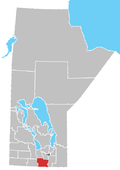This article needs additional citations for verification .(September 2012) |
Rosenort, Manitoba, is an unincorporated community recognized as a local urban district [1] within the Rural Municipality of Morris about 17 kilometres from the town of Morris and about 47 kilometres south of Winnipeg.
Contents
Rosenort is named after a Mennonite village in Imperial Russia, meaning 'Rose Garden' in German. A post office was located on 32-5-1E and was opened in 1899. Rosenort has a K-12 school that is a part of the Red River Valley School Division.
Rosenort was established in 1874 after David Klassen, a Kleine Gemeinde Mennonite delegate and signer of the Privilegium decided to establish a settlement along what is now called the Morris River rather than settle in the nearby East Reserve. The area became known the Scratching River Settlement. The community was settled by 31 Plautdietsch-speaking families of Mennonites of Dutch descent, who came from the Molotschna colony in the Russian Empire, whose descendants continue to have a significant presence in the community.
